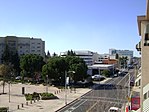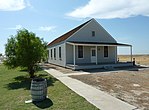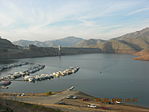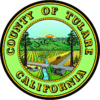
A | B | C | D | E | F | G | H | CH | I | J | K | L | M | N | O | P | Q | R | S | T | U | V | W | X | Y | Z | 0 | 1 | 2 | 3 | 4 | 5 | 6 | 7 | 8 | 9
Tulare County, California | |
|---|---|
Images, from top down, left to right: Acequia Avenue in Visalia, Allensworth Hotel in Colonel Allensworth State Historic Park, Moro Rock in Sequoia National Park, Lake Kaweah | |
 Interactive map of Tulare County | |
 Location in the state of California | |
| Coordinates: 36°14′N 118°48′W / 36.23°N 118.80°W | |
| Country | United States |
| State | California |
| Regions | San Joaquin Valley and Sierra Nevada |
| Metro area | Visalia-Porterville Metropolitan Area |
| Incorporated | 1852 |
| Named for | Tulare Lake, which is named for the tule rush that lined its shores |
| County seat | Visalia |
| Largest city | Visalia |
| Incorporated cities | 8 |
| Government | |
| • Type | Council–CAO |
| • Body | Board of Supervisors |
| • Chair[2] | Eddie Valero |
| • Vice Chair[3] | Dennis Townsend |
| • Board of Supervisors[4] | Supervisors |
| • Administrative Officer | Jason Britt[1] |
| Area | |
| • Total | 4,839 sq mi (12,530 km2) |
| • Land | 4,823 sq mi (12,490 km2) |
| • Water | 14 sq mi (40 km2) |
| Highest elevation | 14,501 ft (4,420 m) |
| Population | |
| • Total | 473,117 |
| • Density | 98/sq mi (38/km2) |
| Time zone | UTC−8 (Pacific) |
| • Summer (DST) | UTC−7 (PDT) |
| Area code | 559, 661 |
| FIPS code | 06-107 |
| GNIS feature ID | 277318 |
| Congressional districts | 20th, 21st, 22nd |
| Website | tularecounty |
Tulare County (/tʊˈlɛəri/ ⓘ tuu-LAIR-ee) is a county located in the U.S. state of California. As of the 2020 census, the population was 473,117.[6] The county seat is Visalia.[7] The county is named for Tulare Lake, once the largest freshwater lake west of the Great Lakes. Drained for agricultural development, the site is now in Kings County, which was created in 1893 from the western portion of the formerly larger Tulare County.
Tulare County comprises the Visalia-Porterville, CA Metropolitan Statistical Area. The county is located south of Fresno, spanning from the San Joaquin Valley east to the Sierra Nevada.
Sequoia National Park is located in the county, as is part of Kings Canyon National Park, in its northeast corner (shared with Fresno County), and part of Mount Whitney, on its eastern border (shared with Inyo County). As of the 2020 census, the population was 473,117, up from 442,179 at the 2010 census.
History

The land was occupied for thousands of years by the Yokuts. Beginning in the eighteenth century, Spain established missions to colonize California and convert the American Indians to Christianity. Comandante Pedro Fages, while hunting for deserters in the Central Valley in 1772, discovered a great lake surrounded by marshes and filled with rushes; he named it Los Tules (the tules). It is from this lake that the county derives its name. The root of the name Tulare is found in the Nahuatl word tullin, designating cattail or similar reeds.
In 1805, 1806 and again in 1816, the Spanish out of Mission San Luis Obispo explored Lake Tulare.[8] Bubal was a native village located on the Western side of Lake Tulare. In 1816, Fr. Luis Martinez of Mission San Luis Obispo arrived at Bubal with soldiers and armed Christian Northern Chumash pressuring the people to send their children for baptism at his mission on the coast. Conflict broke out, and Martinez's party burned Bubal to the ground, destroying the cache of food harvested for the winter.[9] Although Bubal's relationship with the Christian Salinans under Fr. Cabot at Mission San Miguel was better, between 1816 and 1834, Bubal was a center of native resistance. The marshes around Lake Tulare were impenetrable by Spanish horses, which gave the Yokuts a military advantage. At one point, the Spanish considered building a presidio with 100 soldiers at Bubal to control the resistance, but that never came to pass. The Spanish called the natives of the area Tulareños, and before 1816 and after 1834, they were incorporated into Mission San Miguel and Mission San Luis Obispo.[9]
After Mexico achieved independence, it continued to rule California. After the Mexican Cession and the Treaty of Guadalupe Hidalgo in 1848, the area became part of the United States. Tulare County was soon formed from parts of Mariposa County only four years later in 1852. There were two early attempts to split off a new Buena Vista County in 1855 and Coso County in 1864, but both failed. Parts of the county's territory were given to Fresno County in 1856, to Kern County and Inyo County in 1866 and to Kings County in 1893.
The infectious disease Tularemia caused by the bacterium Francisella tularensis is named after Tulare County.
In 1908 Colonel Allen Allensworth and associates founded the town of Allensworth as a black farming community. They intended to develop a place where African Americans could thrive free of white discrimination. It was the only community in California founded, financed and governed by African Americans. While its first years were highly successful, the community encountered environmental problems from dropping water tables which eventually caused it to fail. Today the historic area is preserved as the Colonel Allensworth State Historic Park, which is listed on the National Register of Historic Places.
Geography
According to the U.S. Census Bureau, the county has a total area of 4,839 square miles (12,530 km2), of which 4,823 square miles (12,490 km2) is land and 14 square miles (36 km2), or 0.3%, is water.[10]
Adjacent counties
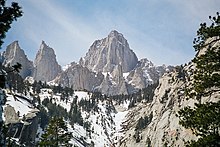
- Fresno County—north
- Inyo County—east
- Kern County—south
- Kings County—west
Lakes

- Arctic Lake
- Bullfrog Lakes
- Columbine Lake
- Crescent Lake
- Eagle Lake
- Franklin Lakes
- Lake Kaweah
- Lake Success
- Rockslide Lake
- Rocky Basin Lakes
- Weaver Lake
Rivers
- Angora River
- Alpine River
- Kaweah River
- Needlerock River
- Monarch River
- Negro River
- St. John's River
- Tule River
- Yokohl River
- Yucca River
Parks
- Colonel Allensworth State Historic Park
- Alpaugh Park
- Balch Park
- Bartlett Park
- Cutler Park
- Dry Creek Preserve
- Horse Creek Recreation Area
- Kaweah Oaks Preserve
- Kings River Nature Preserve
- Lackeys Cabin
- Lake Kaweah Recreation Area
- Mineral King Game Refuge
- Mooney Grove Park / Ancient Oak Forest Preserve
- Sequoia National Park
- Woodville Park
- West Main Street Park
National protected areas
- Blue Ridge National Wildlife Refuge
- Giant Sequoia National Monument (part)
- Inyo National Forest (part)
- Kings Canyon National Park (part)
- Pixley National Wildlife Refuge
- Sequoia National Forest (part)
- Sequoia National Park
Sequoia National Park
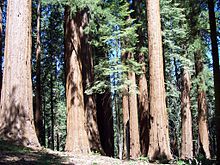
Sequoia National Park is a national park in the southern Sierra Nevada, east of Visalia. It was established in 1890 as the second U.S. national park, after Yellowstone. The park spans 404,051 acres (1,635.14 km2). Encompassing a vertical relief of nearly 13,000 feet (3,962 m), the park contains among its natural resources the highest point in the contiguous 48 United States, Mount Whitney, at 14,505 feet (4,421 m) above sea level. The park is south of and contiguous with Kings Canyon National Park; the two are administered by the National Park Service as one unit, called Sequoia and Kings Canyon National Parks.
Flora
Tulare County is rich in native plant species due in part to a diversity in habitats, including creeks, rivers, hills, and mountains. Native plants include incense cedar (Calocedrus decurrens), valley oak (Quercus lobata), California bay (Umbellularia californica), manzanita (Arctostaphylos manzanita), Salvia spathacea, mountain mahogany (Cercocarpus betuloides), milkweed (Asclepias speciosa), Epilobium cleistogamum, monkeyflower (Mimulus), Penstemon, California melic (Melica californica), and deer grass (Muhlenbergia rigens).[11]
Government and policing
Administration
Tulare County is a general law county under the California Constitution. That is, it does not have a county charter. The county is governed by a five-member Board of Supervisors. Supervisors are elected by districts for four-year terms. There are no term limits in effect. The chairman and vice-chairman are elected annually by the Board of Supervisors from among its members.
Sheriff
The Tulare County Sheriff provides court protection, county jail operation, patrol and detective functions in the unincorporated areas of the county. Incorporated towns have municipal police departments or contract with the Sheriff for their police operations.
Transportation
Major highways
 State Route 43
State Route 43 State Route 63
State Route 63 State Route 65
State Route 65 State Route 99
State Route 99 State Route 137
State Route 137 State Route 180
State Route 180 State Route 190
State Route 190 State Route 198
State Route 198 State Route 201
State Route 201 State Route 216
State Route 216 State Route 245
State Route 245
Public transportation
Tulare County Area Transit (TCaT) provides an intracounty bus service linking the population centers. One TCaT route connects to Delano in Kern County.
The cities of Tulare, Porterville, and Visalia have their own local intracity bus services.
Greyhound and Orange Belt Stages provide long-distance, intercity bus service outside the county.
Airports
The Porterville Municipal Airport, located 3 nautical miles (3.5 mi; 5.6 km) from Downtown Porterville. The airport offers general aviation to the public; it is also home to Porterville Air Attack Base on the south part of the airport. The Visalia Municipal Airport is a city-owned airport for the city of Visalia, California. Mefford Field is a city-owned general aviation airport located in Tulare.
The nearest full-operation commercial airports are Bakersfield's Meadows Field Airport to the south, and Fresno's Fresno Yosemite International Airport to the north.
Crime
The following table includes the number of incidents reported and the rate per 1,000 persons for each type of offense, as of 2019.
| Population and crime rates | ||
|---|---|---|
| Population[12] | 473,117 | |
| Violent crime[13] | 334 | 0.70 |
| Homicide[13] | 9 | 0.01 |
| Forcible rape[13] | 30 | 0.06 |
| Robbery[13] | 64 | 0.13 |
| Aggravated assault[13] | 231 | 0.48 |
| Property crime[13] | 1,893 | 4.00 |
| Burglary[13] | 637 | 1.34 |
| Larceny-theft[13][note 1] | 1,254 | 2.65 |
| Motor vehicle theft[13] | 2 | 0.004 |
| Arson[13] | 0 | 0.00 |
Cities by population and crime rates
| Cities by population and crime rates | ||||||||
|---|---|---|---|---|---|---|---|---|
| City | Population[14] | Violent crimes[14] | Violent crime rate per 1,000 persons |
Property crimes[14] | Property crime rate per 1,000 persons | |||
| Dinuba | 24,685 | 161 | 6.52 | 530 | 21.47 | |||
| Exeter | 10,557 | 26 | 2.46 | 265 | 25.10 | |||
| Farmersville | 10,781 | 35 | 3.24 | 190 | 17.62 | |||
| Lindsay | 13,708 | 69 | 5.03 | 250 | 18.23 | |||
| Porterville | 60,209 | 192 | 3.18 | 1,297 | 21.54 | |||
| Tulare | 65,134 | 261 | 4.00 | 1,469 | 22.55 | |||
| Visalia | 134,961 | 586 | 4.34 | 3,900 | 28.89 | |||
| Woodlake | 7,682 | 28 | 3.64 | 88 | 11.45 | |||
Demographics
| Census | Pop. | Note | %± |
|---|---|---|---|
| 1860 | 4,638 | — | |
| 1870 | 4,533 | −2.3% | |
| 1880 | 11,281 | 148.9% | |
| 1890 | 24,574 | 117.8% | |
| 1900 | 18,375 | −25.2% | |
| 1910 | 35,440 | 92.9% | |
| 1920 | 59,031 | 66.6% | |
| 1930 | 77,442 | 31.2% | |
| 1940 | 107,152 | 38.4% | |
| 1950 | 149,264 | 39.3% | |
| 1960 | 168,403 | 12.8% | |
| 1970 | 188,322 | 11.8% | |
| 1980 | 245,738 | 30.5% | |
| 1990 | 311,921 | 26.9% | |
| 2000 | 368,021 | 18.0% | |
| 2010 | 442,179 | 20.2% | |
| 2020 | 473,117 | 7.0% | |
| 2023 (est.) | 479,468 | [15] | 1.3% |
| U.S. Decennial Census[16] 1790-1960[17] 1900-1990[18] 1990-2000[19] 2010[20] 2020[21] | |||
2020 census
| Race / Ethnicity | Pop 2010[20] | Pop 2020[21] | % 2010 | % 2020 |
|---|---|---|---|---|
| White alone (NH) | 143,935 | 125,022 | 32.55% | 26.43% |
| Black or African American alone (NH) | 5,497 | 5,332 | 1.24% | 1.13% |
| Native American or Alaska Native alone (NH) | 3,323 | 3,458 | 0.75% | 0.73% |
| Asian alone (NH) | 14,204 | 15,997 | 3.21% | 3.38% |
| Pacific Islander alone (NH) | 370 | 511 | 0.08% | 0.11% |
| Some Other Race alone (NH) | 641 | 2,132 | 0.14% | 0.45% |
| Mixed Race/Multi-Racial (NH) | 6,144 | 10,770 | 1.39% | 2.28% |
| Hispanic or Latino (any race) | 268,065 | 309,895 | 60.62% | 65.50% |
| Total | 442,179 | 473,117 | 100.00% | 100.00% |
Note: the US Census treats Hispanic/Latino as an ethnic category. This table excludes Latinos from the racial categories and assigns them to a separate category. Hispanics/Latinos can be of any race.
The 2020 United States Census reported that Tulare County had a population of 473,117 and the population was spread out, with 31.0% under the age of 18, 69.0% from 18 to 64, 6.5% from 65 to 74, 3.2% from 75 to 84 and 1.4% who were 85 years of age or older. The median age was 31 years.[12]
The racial makeup of Tulare County including Hispanics was 186,255 (39.4%) White, 6,668 (1.4%) African American, 10,645 (2.2%) Native American, 17,194 (3.6%) Asian, 723 (0.1%) Pacific Islander, 165,230 (34.9%) from other races, and 86,402 (18.2%) from two or more races. There were 309,895 people (65.5%) of Hispanic or Latino origin, of any race.[22] 3.7% were of German, 3.2% English, 2.8% Irish, 2.4% Portuguese and 2.3% American ancestry according to Census 2020. 48.7% spoke English, 47.4% Spanish and 1.0% Indo-European as their first language.
There were 144,109 households, out of which 45.9% had children under the age of 18 living with them, 52.5% were married couples living together, 15.2% had a male householder with no spouse present, 24.1% had a female householder with no husband present, 20.8% were non-families, and 8.1% had someone living alone who was 65 years of age or older. The average household size was 3.20 and the average family size was 3.57.[12]
There were 150,652 household units, and 141,987 occupied housing units in the county. The population density was 98.1 people per square mile (37.9 people/km2).[23]
The median income for a household in the county was $57,692, and the median income for a family was $53,330. The per capita income for the county was $23,096.[24] About 18.8% of the population were below the poverty line, including 26.0% of those under age 18 and 13.8% of those age 65 or over.

